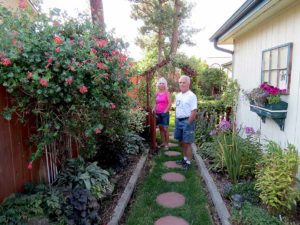Sept. 25 column: Drip irrigation

Throughout the growing season, I enjoy profiling local gardeners. Especially those who have a spectacular garden or a special skill to share with you. In today’s column, Tracy and Alan Lewis have both! They explained how they set up a drip irrigation system as an add-on to their existing sprinkler system. Here’s a link to it: Drip system need not be daunting.
You can also read my column below.
I think a lot of folks feel daunted by the prospect of configuring a drip irrigation system. Or they think it has to run independently of regular sprinklers. The Lewises were more than happy to share what they did and why they did it. They explained how they accomplished their goal of getting just the right amount of water to their entire landscape.
Tracy Lewis is a Master Gardener who definitely has a green thumb and an eye for garden design. I hope you’ll enjoy reading about their garden and feel inspired to delve into the world of drip irrigation.
Column:
by Susan Mulvihill
Adding a drip irrigation system to your existing sprinkler system can seem like a pretty daunting prospect. But think about the process you go through when undertaking any new project. First, you do a bit of research and get advice from someone who has done it before. And then you dive in.
Meet Alan and Tracy Lewis
That’s exactly what Alan and Tracy Lewis did in their south Spokane yard and the results are impressive. Tracy is a Spokane County Master Gardener with an eye for plants.
“I love heucheras (coral bells), sun and shade perennials, plants with interesting foliage — a real variety of things,” she admitted. “I frequently bring home new plants which has gotten me into trouble with Alan. That’s because he’s had to figure out how to get water to them.”
The original watering system wasn’t working
When they moved into their home 16 years ago, there was a basic sprinkler system and minimal landscaping. As Tracy began creating and planting beds, she noticed how some plants just weren’t getting enough moisture. The sprinklers kept the lawn green, but that was it. Since their yard sits on top of basalt rock, there wasn’t much soil to retain moisture anyway.
There was also the matter of the narrow side yard. One side bakes in the sun while the other is cloaked in shade.
A drip irrigation resource
It was a bit of good fortune that their friend, Dan Loibl, was a great resource. He has had a great deal of experience customizing a drip irrigation system for his own place. Alan quickly peppered him with questions.
“The biggest challenge for me was just being ignorant on what to do,” Alan said. “It was hard getting started. But I’ve found if someone can just walk you through it, you’ll have a better understanding.”
How the new drip irrigation system is set up
The Lewis’s sprinkler system was constructed from PVC pipe. That made it easy for them to tap off of the pipes with drip irrigation hoses and tubing.
Alan found all of the parts he needed at a South Hill hardware store. Loibl suggested he stick with a single brand of drip irrigation supplies. That’s because some connectors from other brands might not fit with what he’d already purchased.
Tracy grows perennials, shrubs, container plantings, trees, and vines. She has found that drip irrigation works well for all of them. They use shrub sprayers, emitters, and both 1/4-inch and 1/2-inch drip tubing.
Misters water each of the hanging baskets on the pergola over their patio. They also water the tomatoes and herbs planted in pots below.
“I’ve found using a drip system saves us money because we’re watering less and they’re more adjustable,” she explained. “For example, when you first start your containers in the spring, they don’t need much water. But as the plants grow, you can adjust a valve so the drippers provide more water.”
After Alan had installed much of the system, Tracy related how she brought home one carload too many of new plants.
“He didn’t want to add to the system once again, so I decided I’d better figure out how to do it myself,” she admits.
What did she learn?
“Use a hair dryer to make connections go together more easily,” she advised. “In addition, a lot of fittings need friction to go together and can break easily. Use garden gloves that grip well.”
Despite the occasional arrival of new plants, Alan is pleased with how everything has come together.
“The drip system is awfully nice because it’s flexible. We can get the water right where it needs to be. And if I can do it, anybody can.”
Susan Mulvihill is co-author, with Pat Munts, of “Northwest Gardener’s Handbook.” Contact her at Susan@susansinthegarden.com.

